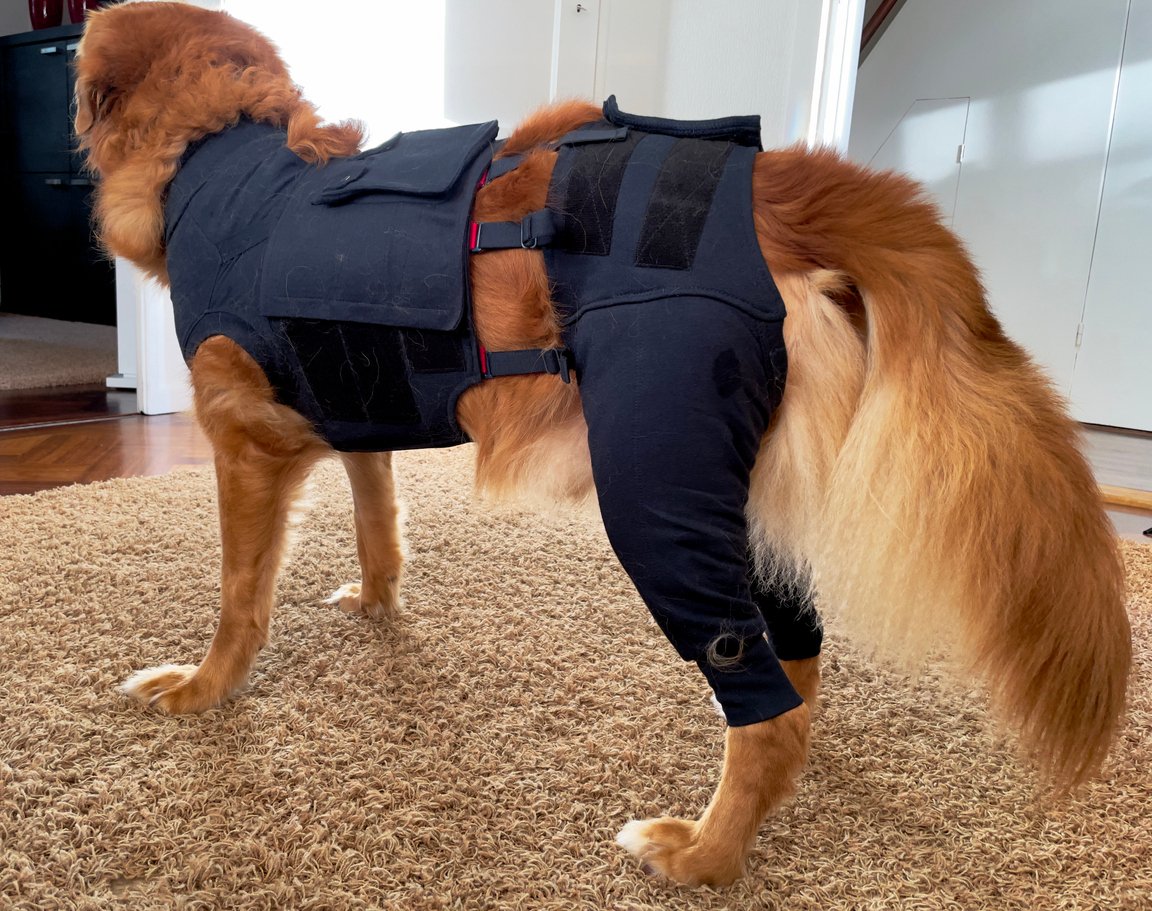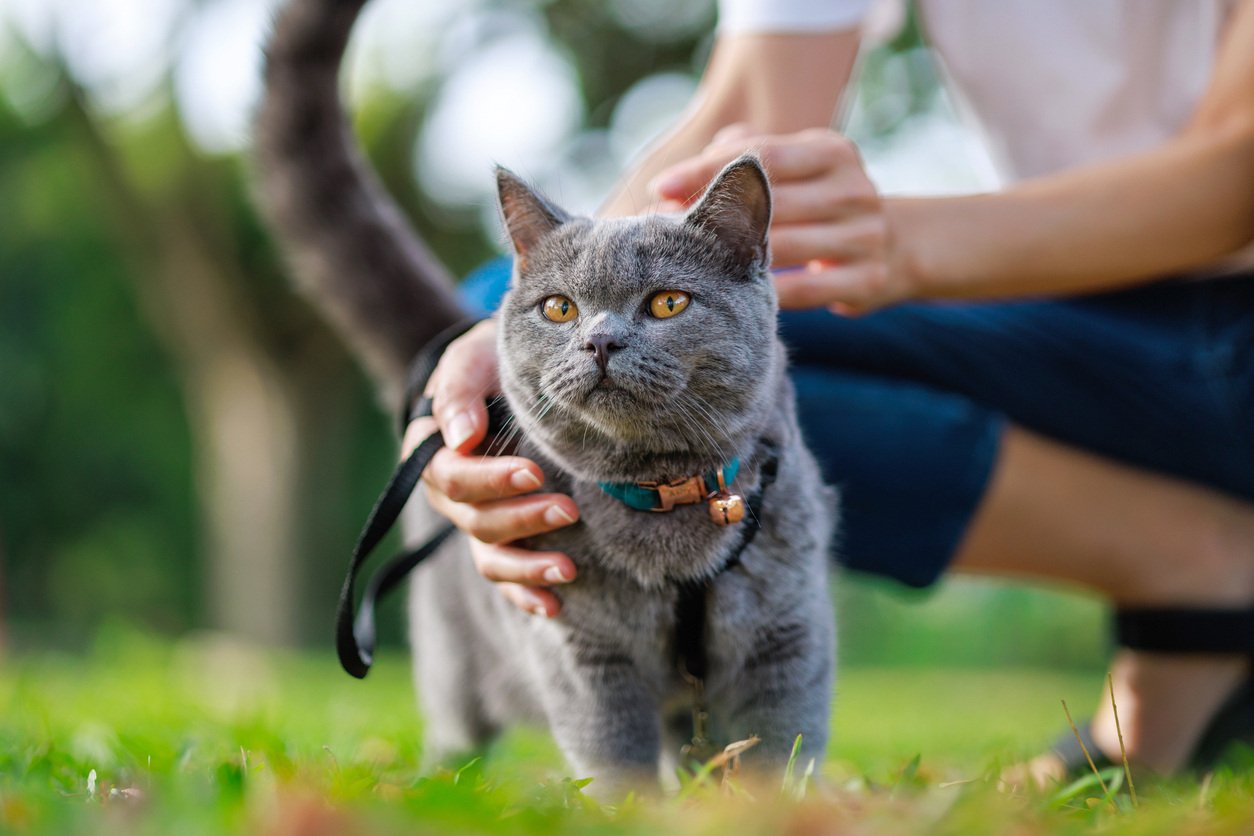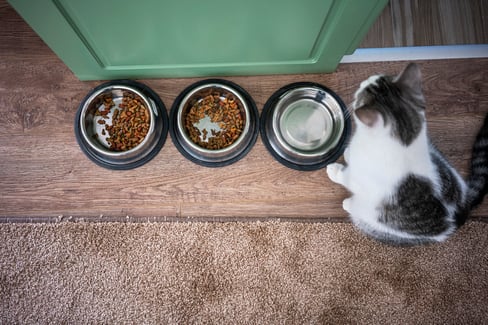Table of Contents
It’s finally happening—your new kitten is ready to come home! You’ve got the cozy bed, the adorable toys, and enough treats to spoil them rotten. It's time for cuddles, purrs, and... oops. A tiny accident on the floor.
While your kitten may already be a champion at zoomies and adorable chaos, litter box skills usually need a little work.
The good news? Litter training a kitten is way easier than potty training a toddler (and involves a lot fewer stickers and tears). With the right supplies and a sprinkle of patience, you can have your kitten confidently using the litter box in just a few weeks.
If you’re wondering how to litter train a kitten and also want some insight into general kitten care, you’re in the right place. Keep reading for everything you need to know to make litter training a breeze!
How to Start Litter Training Kittens
Early kitten litter box training is recommended for cat breeders or those whose cat has a new litter of kittens. While your kittens won’t be fully litter trained by the time they’re ready for adoption, at around eight weeks old, starting the litter box training early is best for the kitten…and appreciated by their new owners!
If you’ve adopted a new kitten, chances are your furry friend is ready for their kitty litter training.
The Best Age to Begin Litter Training a Kitten
Cats can begin kitten litter training from as early as four weeks old. This coincides with when kittens start weaning from their mother’s milk and are ready to be introduced to the best kitten food.
Four signs newborn kittens are ready to be weaned include:
- Increased mobility
- Development of deciduous canines and incisors (baby teeth)
- Becoming playful and independent
- Showing interest in their mother’s food
Before kitten litter training, a mother cat will stimulate their kittens to eliminate waste and clean up after them. If your cat has a litter of kittens, you can expect her to ingest their waste as part of the natural grooming process for the first few weeks immediately after birth.
Once your cat reaches 3-4 weeks of age, they naturally begin to dig into dirt and search for dry, loose material to use as a bathroom. This is the perfect time to start training kittens to use litter!
Choosing the Right Litter Box & Supplies
One of the most important parts of kitten litter training is choosing the right litter box and supplies. As you learn how to take care of a cat, you’ll discover that felines can be quite particular when it comes to their food, bedding, and creature comforts; litter boxes are no exception!
Litter box training a kitten can be messy and requires a lot of patience. There will likely be some trial and error along the way of your kitten litter training journey.
Before kitten litter box training, you will need to consider the following:
- Kitten Litter Box Selection
- Litter Selection Considerations
- Litter Cleaning Supplies
Kitten Litter Box Selection
Litter box selection is extremely important, especially for young kittens. Choosing a comfortable litter box can greatly affect the success of early litter box training.
Things to keep in mind when choosing a kitten training litter box include:
- Size of Litter box: A full-sized litter box will likely be too big for a newborn kitten. Choose a shallow litter pan or cut the sides of a larger one.
- Covered vs Un-Covered: Most cats prefer uncovered litter boxes. Covered litter boxes can be intimidating to young kittens, so they might avoid using them.
- Multiple Litter Boxes: If you have more than one cat, you should have multiple litter boxes. Ideally, you should have one litter box per cat plus an extra.
- Kitten Training Pads: Pet training pads can be used around the litter box to catch additional messes. You can also put them in playpens to get your kitten comfortable with a designated bathroom area.
Litter Selection Considerations
Cats can be picky when it comes to their litter. There are so many cat litter options available on the market, most of which have qualities more preferable to the owner and not the cat. It might seem smart to buy odour-eliminating litter, or purchase fancy crystals to reduce mess. However, your cat may think otherwise!
You will also want to consider clumping vs. non-clumping cat litter for options where it is available. Refer to the chart below to compare clumping vs. non-clumping cat litter.
|
Clumping Cat Litter |
Non-Clumping Cat Litter |
|
|
Clumping cat litter is often cheaper and more readily available. Because it clumps, soiled areas can be scooped out, requiring less changing than non-clumping litter. However, clumping litter is very heavy when soiled, and can easily make you go over your weight limit on garbage day. Many cat owners find clumping litter to be messier, as it is fine and dusty, leaving paw prints on furniture.
The most common types of litter for kitten training include:
- Clay Cat Litter
- Crystal Cat Litter (i.e., Silica Gel)
- Natural Pebble Cat Litter
- Paper Pellet Cat Litter
- Corn Cat Litter
- Walnut Cat Litter
- Pine Cat Litter
Refer to the chart below for an overview of the most common litter types for kitten litter box training.
|
Litter Type |
Description |
|
Clay Cat Litter |
|
|
Crystal Cat Litter (i.e., Silica Gel) |
|
|
Natural Pebble Cat Litter |
|
|
Paper Pellet Cat Litter |
|
|
Corn Cat Litter |
|
|
Walnut Cat Litter |
|
|
Pine Cat Litter |
|
Feral cats instinctively seek out sandy or grainy areas to bury their waste, so it makes sense that their litter mimics this preference. That is why veterinarians recommend fine-grained, odorless litter.
If you have to change litter types, you should do so gradually to avoid stressing out your kitten and regressing the litter box kitten training process. Start by mixing in small amounts of the new litter with the old litter, and increase the amount of new litter with every cleaning.
Litter Cleaning Supplies
Pet experts recommend spot-cleaning litter boxes daily and replacing litter at least once every 2–4weeks, depending on how many dirty particles are left behind in the litter (small clumps that sift through your litter scoop).
To keep your litter for kitten training clean, you’ll need some basic litter box cleaning supplies:
- Litter scoop
- Disposable waste bags
- Cleaning rag
- Scrub brush
- Dish soap
- Baking soda
Once or twice daily, scoop out clumps of litter or visible waste, dispose of the waste in disposable waste bags, and sprinkle a layer of fresh litter on top.
Follow these step-by-step instructions for how to keep a kitten litter box clean:
- Empty the litter in a garbage bag.
- Soak the litter box in hot water with dish soap for several minutes.
- Dump the water and dish soap.
- Use a scrubbing brush or rag to clean out the litter box.
- Dry with a clean towel and allow the box to air dry completely.
- Sprinkle baking soda on the bottom of the litter box (optional).
- Refill the litter box with fresh litter.
Setting Up the Perfect Litter Training Environment
The basics of how to litter train a kitten involve setting up the perfect litter training environment. Once you have your litter box and kitty litter selected, it’s time to set up the perfect powder room for your furbaby.
Where to Place the Kitten Potty Training Litter Box
Where to place the kitten potty training litter box depends on your household's layout and traffic. While some cat owners prefer to keep litter trays out of sight in a bathroom or laundry room, you might need to be flexible with litter box placement while training a kitten to use a litter box.
Consider the following when choosing a placement for box training kittens:
|
Litter Placement Consideration |
Description |
|
Privacy |
Choose a spot away from your main living areas. |
|
Lighting |
Make sure the area is not pitch-black; consider a nightlight or dim lighting. |
|
Traffic |
Make sure your kittens won’t be interrupted by your household activities. |
|
Accessibility |
Ensure a clear path to the litter box. |
|
Distractions |
Avoid an area with plants, strong odours, or noises. |
|
Multiple Floors |
Have a litter box on each floor where your kittens spend time. |
How Many Litter Boxes You Should Have Per Kitten?
Multi-cat households need multiple litter boxes. As a general rule, you should have one litter box per cat, plus one extra.
However, this might not make sense in all situations. For example, a small apartment requires only one litter box per cat. But if you have a large, three-floor house, having at least two litter boxes for a single cat makes more logical sense. Use your best judgement and your knowledge of your cat(s) behaviour to make the best choice. For example, some cats might not want to use a litter box that another cat has already used, so in those cases, an additional litter box would make sense. Other times, you might have a cat with health problems that needs close access to a litter box at all times, meaning you’ll want to make sure there’s an accessible one near them, regardless of where they are in your home.
How To Make The Litter Box Easily Accessible?
When training a kitten to use the litter box, you will want to ensure that the litter boxes are easily accessible. Your kittens should be able to easily find their litter box after eating, playing and sleeping.
Tips to creating an accessible area for litter training kittens include:
- Choose an area close (but not too close) to food bowls and beds.
- Start with a small, shallow litter tray.
- Remove clutter and furniture around the litter box.
- Avoid placing the litter box near areas where sudden movements or loud noises may occur, like the laundry room.
Training a Kitten to Use the Litter Box Step-by-Step
Training kittens to use litter boxes effectively doesn’t happen overnight. While cats and kittens are naturally fast learners, they still need demonstrations, praise, and encouragement, just like we do when learning a new skill.
If you’re litter box training a very young kitten, be sure to check out our 4-week-old kitten care guide.
The First Few Days of Box Training a Kitten
When you start box training a kitten, the first few days require time and patience. Be sure to set aside a few days of quiet, uninterrupted time at home to allow your kittens to be accustomed to their litter box. Look for the signs they’re ready for the bathroom, establish a routine, and offer praise for positive behaviour.
As you start to litter box train kittens, look for the following signs that a kitten needs to go to the bathroom:
- Sniffing the ground
- Vocalizing
- Digging and scratching
- Circling around
- Crouching
Follow these simple step-by-step instructions for how to litter train a kitten:
- Assemble Supplies: Be sure to have purchased your preferred kitten litter box, kitten litter, and cleaning supplies.
- Prepare Litter Training Area: Assemble your litter box in a quiet and private area that is easily accessible.
- Introduce Your Kitten: Place your kitten in the litter tray and allow them to sniff and explore the area. Do not distract your kitten while they are in the litter box.
- Create a Routine: Place your kitten in the litter box after meals and naps to encourage natural elimination habits.
- Look for the Signs: Place your kitten in the litter box when they are digging, sniffing the ground, or circling around.
- Positive Reinforcement: Reward your kitten with praise or treats when they use the litter box./li>
Positive Reinforcement for Successful Litter Box Training
Much like how we teach our young children proper social graces and behaviour, we want to take a ‘gentle parenting’ approach when we teach litter training for kittens.
https://media4.giphy.com/media/v1.Y2lkPTc5MGI3NjExenpvem9rc2k4czJsejcwM3U0NjBmNDNlNm5lOXN1N202MWNxcHYzYyZlcD12MV9pbnRlcm5hbF9naWZfYnlfaWQmY3Q9Zw/KrDrFbt1EEAchQTPco/giphy.gif
Positive reinforcement is the preferred way of teaching kittens proper behaviour. It is a necessary tool when learning how to care for a kitten. With cats, it is easy for them to swap one negative behaviour for another. For example, if you scold a cat for using your dining room rug as a bathroom, they might use your front door mat the next time…right before you welcome company!
Positive reinforcement techniques include gentle strokes, light excitement, and offering a treat to your kitten. Patience is key as you pursue how to litter train a kitten.
Handling Accidents & Common Setbacks
Accidents happen when litter training kittens. Just when you think you’ve successfully mastered litter training kittens, you notice an accident or find unpleasant surprises in unusual places: your bed, a closet, or even your shoes!
The most common reasons for problems with litter training kittens are changes in your routine or environment.
Routine and environment changes that can lead to problems litter training kittens include:
- Being away overnight
- Vacations
- Overnight visitors;
- Furniture changes
- Adjusted room layout
If your kitten refuses to use the litter box or stops using it due to a change in its environment, it’s important not to scold or punish it. Allow your kitten time to adjust to the changes, keep placing them back in their litter box, and offer praise for proper bathroom behaviour.
When cleaning up accidents, calmly clean the area. Pick up the accidents and place them in the litter box to show your kitten, “This is where we go to the bathroom.”
Solving Litter Training Kittens Problems
Sometimes, your kitten or cat might protest their litter box for an extended time. If there have been no significant changes to your environment or routine, you may need to do some investigative work to solve problems with litter training kittens. Common litter training issues include stress, health concerns, litter box set up, and litter preferences.
Why Is My Kitten Not Using the Litter Box?
The first thing to assess when wondering “why is my kitten not using the litter box” is any changes you have implemented to the litter box or your home environment since starting training. If your kitten hasn’t taken to the litter box at all, consider making changes to its bathroom.
Refer to the chart below for a breakdown of reasons for common litter training problems
|
Litter Training Kittens Problems |
Explanation |
|
Health Concerns |
|
|
Stress and Anxiety |
|
|
Litter Preferences |
|
|
Litter Box Set Up |
|
|
Litter Hygiene |
|
There are several cat health concerns that can affect litterbox training. Medical issues such as urinary tract infections and kidney problems directly impact a kitten’s ability to hold their bladder. Other concerns, like arthritis and joint problems, can impact a cat’s ability to hop in and out of a litter box or get to one quickly. Consider cat supplements to support your kitten’s health from early kitten to adulthood. Joint supplements for cats like TRI-ACTA can be taken proactively to support healthy joints and improve mobility.
TRI-ACTA for Pets
A proactive approach for developing and younger adult pets to maintain optimal joint health mobility, minimize inflammation and fend off age-related ailments.

Stress and anxiety are also factors in litter training a kitten. Cats are quite anxious creatures and do not like loud noises or overstimulation. Adjusting litter box placement and environment might be useful if you have other pets or young children. Other factors, like addressing litter texture preferences or simply maintaining a hygienic litter box, might be a simple cause of kitten litter training problems.
Litter Box Training for Multiple Kittens
If your cat is a new mom to a litter of kittens, or you adopt more than one kitten at once, you’ve come to the right place for litter box training for multiple kittens.
Follow these tips for how to handle training kittens to use the litter box in shared spaces:
- Ensure each kitten has their own litter box training setup.
- Have one additional litter box.
- Make litter box areas visible and accessible.
- Spot clean litter boxes twice daily.
- Change litter once or twice a week.
- Clean up accidents promptly.
- Offer praise when a kitten uses their litter box.
Follow the same golden rule of litter boxes for multi-cat households: one litter box per cat plus an additional litter box. Keep litter boxes clean and tidy and make all litter boxes visible and easily accessible for newborn kittens.
How to Litter Train a Kitten: Final Thoughts
By following these tips for litter training kittens, you can have your kittens toilet-trained in as little as a few weeks. Kittens and litter box training can be a lot of work, but with the right tools, you can easily master how to take care of a kitten and box train kittens.
Be sure to consider your kitten’s health from the time of adoption. Investing in proper nutrition and supplements helps optimize your kitten’s health and quality of life.
Explore options for cat supplements like TRI-ACTA for Pets to support healthy joints and improve mobility as your kitten grows. TRI-ACTA uses 100% active ingredients designed to support their growth and joints for a long and healthy life.
TRI-ACTA for Pets
A proactive approach for developing and younger adult pets to maintain optimal joint health mobility, minimize inflammation and fend off age-related ailments.

Newsletter Signup
Subscribe to our newsletter to receive the latest news and exclusive offers.
.jpg?height=2000&name=Cliick_Integricare-DISPLAY-REVISEDV2%20(1).jpg)
Proactive & Therapeutic Joint Supplements
When given daily, Integricare joint supplements recover bone and joint injuries faster and help prevent mobility injuries from happening in the first place.









